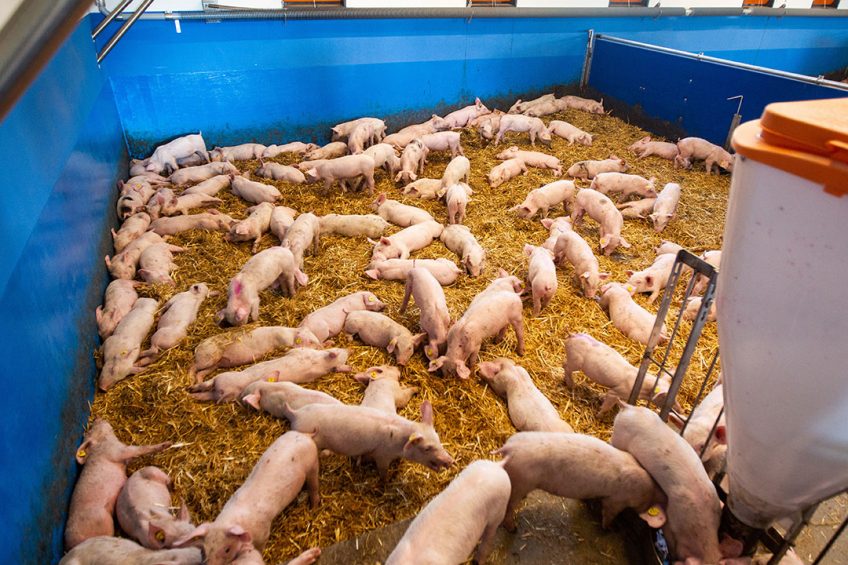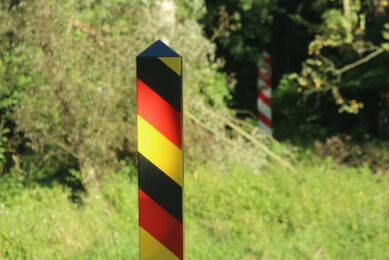Warm bed of straw beneficial for grower pigs

The farm of pig producer Heinz* in the German district of Cloppenburg, Lower Saxony, Germany, is being made ready to keep pigs in an automatised system on straw. Manure is being composted.
Recently, the interior of one of the two piglet houses of pig producer Heinz* in Lower Saxony has been completely revamped. Colours blue and orange have been dominating ever since. The reason is that animal nutrition company Bröring and pig equipment company Big Dutchman have become very involved in the farm. They have discovered a promising concept in Heinz’ farm houses. After all, for years, the pig producer has been keeping piglets on a thick bed of straw. More than 15 years ago, he converted his previous broiler facilities into weaner houses. An investment for a manure pit underneath proved a bridge too far at that moment, hence he opted for straw.
A nice view
To be fair – it looks good to see the animals on a thick bed of straw. The piglets are laying spread out over the pen and appear to be happy. One pig is nibbling on a piece of straw whereas others keep themselves busy at the feed or water trough. They defecate in the back of the pen, in the corners, as much as possible. The lion’s share of the floor is therefore moistureless, shortly after the introduction of the pigs. Heinz takes pride in showing how well the defecating behaviour is in the pig house. He jumps up and down a few times on top of the straw in the corner where the animals’ manure can be found. Proudly he says, “Look, one doesn’t sink away.”
With his ‘act’, he shows that the urine has evaporated and that manure is composting, together with the straw, into a solid layer. To support that, Big Dutchman’s Daniel Holling places a thermometer in the bed of straw: 37ºC. No surprises there, he says. Under virtually anaerobic conditions, the manure and the straw will compost, at a temperature which is constantly between 35 and 42ºC. As a result of the heat that is created, the urine will evaporate, both gentlemen state.

Concept of pig houses with straw
Jointly, Big Dutchman and Bröring developed a concept for pig houses with straw. The result is a combination of feed, pig house design, equipment, straw and climate, which ensures that the ‘Xaletto’ principle will function well. Both companies state that they have come so far now to be able to say that the concept is automated with predictable results. That means: clean piglets, which are growing well, in a fresh environment and leaving behind a by-product that can be completely composted to useful manure for in gardens.
Xaletto does not only stop at grower pigs. About 300m down the road, construction works are going on for the renovation of two pig houses for both growers as well as finishers, according to the ‘wean-to-finish principle’. This means that piglets will go into the straw pens after weaning and will get out as soon as they are ready for a trip to the slaughterhouse.
The basic principle of these grower/finishing pig houses is similar to the piglet houses. One difference is that the pigs need to take two steps to reach their feed and water troughs. The reason behind that is that the pigs will stay in there for longer and that the straw layer will get thicker than in a piglet house. The feed trough, however, needs to be accessible at all times.

In these pig houses, Big Dutchman is constructing a straw dispenser, making manual labour disappear. The straw will be processed prior to use, opening up the stem, which allows it to absorb more moisture. The treated straw will then be added to big bags and will be stored for later use.
Once a week, Heinz will send fresh straw into his pens. In the current pig houses, this will happen by hand. The pig house construction is simply too light for the installation of a straw dispensing unit.
The last step of the concept consists of a full composting of the manure. As soon as the pig house is empty, the manure will be taken out of the pig house by a shovel, after which the manure will be composted. That is why, in the same warehouse where the straw was stored, also bags can be found with nice, dry compost. The by-product is supplemented by wood chips, which can be sold.

Completely automated
There is no manual labour needed in the modern straw pig house. All processes are automated. In front of the piglet houses, there are climate computers. These have been installed by the pig house designer and only the temperature can be regulated. It’s impossible for pig producers to make mistakes, states Mr Holling. Most of its functions are kept secret, the only thing he can reveal is that the humidity is closely monitored, together with a number of other variables. In the Xaletto concept it is important that the piglets grow well and that the straw being digested well.
To enhance this digestion process, a special catalyser is being applied on the floor prior to the introduction of the piglets. This is done to stimulate the digestion of the straw. The piglet feed has been constructed in such a way, that the result is healthy, black pig manure. The manure and the straw will immediately react.
Technical results
As long as they continue to work within the Xaletto guidelines, about 1kg straw is needed per 10kg of feed. Per pig place, this means about 30kg of straw per year. For a finisher place, both companies expect to need about 90kg of straw per year.

Heinz tells that in all the years he has been keeping his piglets on straw, he has managed to improve the concept bit by bit. Ever since, Bröring and Big Dutchman have been involved with the straw concept, developments have gone quickly, he says. The climate system has been revised, there are new LED lights inside the pig house, and also the new drinking troughs have got built-in sensors. That way, there will always be a thin layer of water in the trough, with the result of hardly any water is being spilled and the first part of the pen will remain dry. The pigs’ dry feed is automatically distributed; the feeding process is completely automated.
The piglets do well, Heinz says, “Growth in the phase between 7-30 kg is about 450 g/day. Mortality is low, below 1%. Over 97% of the growers are being shipped against market prices.”
A small percentage will not be suitable for sale as quality grower. The pig producer is convinced that he can keep the pigs with entire tails in this pig house. At this moment, it doesn’t happen, because no finisher pig producer, buying his grower pigs, is willing to buy growers with entire tails.

Ammonia concentrations
In the piglet house that has not been renovated yet, there are pigs almost at slaughterweight. Nevertheless there is no pungent smell in the pig house. According to the climate computer the ammonia concentration is 5ppm. According to Mr Holling, that is about 30% of what a conventional pig house without air scrubber would do.

Check out Pig Progress’ Country Focus section
The straw concept thus tackles the problem of ammonia emission at its source. The most remarkable is that the ammonia concentration will drop as soon as the grower pigs will remain longer in the pig house, according to test results. Nevertheless, Big Dutchman will equip the pig houses with additional air scrubbers for more ammonia reduction.
In the meantime, Heinz steps into his pig house with a big fork and he tosses around in the straw bed of the large growers. He demonstrates that it is dry and compact and that the pigs do not sink away. Neither is there a pile of manure.
At the moment, 12 farms have shown interest in Xaletto, Mr Holling says. The investment of a pig house like that can be found in Table 1. The return on investment of a Xaletto concept will depend on costs to get rid of manure as well as the price of selling the compost.
|
* For reasons of privacy, only the pig producer’s first name is being used.


 PROFILE
PROFILE








